
|
Sale 16
Pre-Long Beach Coin and Currency Auction
| Lot |
Photo |
Description |
Realized |
Lot 51 |
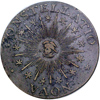 |
1783 Nova Constellatio. Pointed rays, small U.S. PCGS graded AU-50. Medium to light brown in color, but the planchet has some rough areas, particularly at the upper left obverse. Boldly struck on the devices, including the central all seeing eye, which retains more definition than usual. Traces of red coloring on both sides from age. A very acceptable high grade example of this type.
Estimated Value $1,000 - 1,200.
View details and enlarged photos
| Unsold |
Lot 52 |
 |
1785 Nova Constellatio. Pointed rays. PCGS graded EF-40. Medium to dark brown in color and nicely struck and preserved. A popular and important colonial issue.
Estimated Value $700 - 800.
View details and enlarged photos
| Unsold |
Lot 53 |
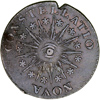 |
1785 Nova Constellatio. Pointed rays. Sharpness of EF-40 but porous and a small rim cut. Well struck on the devices, but we note a small area of corrosion on the obverse edge right of the date. There is also a small notch cut out of the edge, and perhaps this was used as a gun site. Colonial Americans being a thrifty sort, they used whatever they could find to serve their purpose, in this case a round metal object would do well if a small notch was cut at the rim.
Estimated Value $250 - 350.
View details and enlarged photos
| Unsold |
Lot 54 |
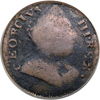 |
1785 Immune Columbia. George III obverse. SEGS graded Fine-12"Corroded" and "*" holder. Dark patina in the fields with lighter copper on the devices and lettering. As always seen on this issue, the planchet was a touch small and the tops of the date are all that show. There is a rough area noted in the right obverse field. Breen notes that this coin was struck around May to July of 1789. While not the most perfect surfaces, this is a rare coin which is seldom offered at all, and never in nice condition. Note that PCGS has not graded any of this issue, confirming the rarity. Breen-1000 per his Encyclopedia with the spelling Ceorcivs III. Rex as the "G" punch was broken or missing at the time the dies were engraved.
Estimated Value $2,500 - 3,500.
Purchased from the CCCC annual auction a few years ago and from the Paul Arthur Norris Collection.
View details and enlarged photos
| Realized
$2,875 |
Lot 55 |
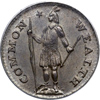 |
1787 Massachusetts Half Cent. PCGS graded MS-66 Brown. Satiny brown luster in the fields, and truly a superb example of this important Massachusetts state issue. All devices are bold save for the very centers, which display trace weakness on the high points. Struck on a good, clean planchet, with only minute flaws seen near the right obverse rim. Free of spotting or similar problems, and the fields and devices are without a blemish even under the scrutiny of a strong 10X glass. Certainly one of the finest known, PCGS has graded 3 coins this high, with none graded higher, further none have been seen in the red and brown or full red category of grades either. The die diagnostics of the minor crack through the right foot of the Indian are present, as well as the configuration of the arrows and leaves on the reverse confirm this is a Ryder 4-C variety.
These Massachusetts coins were designed by Joseph Callendar according to the specifications of the Governor and Council. The engravers were Joseph Callendar and Jacob Perkins and the coins were struck at Joshua Wetherle's Mint in Boston. Naturally, the demand for small change was great, so few were saved in high grades, and most circulated for many years. The Massachusetts coinage was the first appearance of the decimal coinage proposed by Congress in 1786, and the only half cents issued by a state. How this one survived in such pristine condition remains a numismatic mystery, but here it is.
Estimated Value $10,000 - 12,000.
From the Paul Arthur Norris Collection.
View details and enlarged photos
| Realized
$6,900 |
Lot 56 |
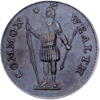 |
1787 Massachusetts Cent. Arrows in left talon. PCGS graded AU-55. A condition rarity in this grade. Toned a dark chocolate brown and very sharp, with no signs of weakness, and the surfaces are absolutely problem free. PCGS has graded only 4 as such, with 1 higher in the brown category, and a single mint state coin is reported in the red and brown category at the top for this variety. An exciting specimen for the specialist who demands copper coins as perfect as they can be found.
Estimated Value $1,500 - 2,000.
View details and enlarged photos
| Realized
$1,553 |
Lot 57 |
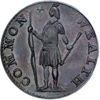 |
1788 Massachusetts Half Cent. PCGS graded MS-65 Brown. Satiny brown luster on both sides, and very well preserved for this gem grade. The upper devices show a trace of weakness on the Indian and his head, and at the central shield, although HALF CENT is clearly visible. One of the very finest graded of this date by PCGS, they report 2 this high with a single coin graded higher as MS-66 Brown. An exciting opportunity for the colonial specialist to be able to pick and choose from several very important coins in this sale.
Estimated Value $5,000-UP.
View details and enlarged photos
| Unsold |
Lot 58 |
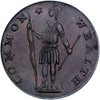 |
1788 Massachusetts Cent. Period after "Massachusetts". PCGS graded MS-65 Brown. This is the finest graded of this date by PCGS, and alone as the sole MS-65 in any color category. Perhaps it is the very finest known of the entire issue, although such claims are ill advised without extensive research. Further, this is a scarce issue, and we note the strike is quite sharp, even on the upper devices, with CENT sharp. The planchet wasn't perfect on the very extremes of the edge, and this caused the A of WEALTH to be poorly struck up, and other areas are similar. Traces of mint red are noted on the reverse. A strong glass will note some very trivial pin lines near the lettering on the reverse. If you demand the finest, then here it is.
Estimated Value $8,500-UP.
View details and enlarged photos
| Unsold |
Lot 59 |
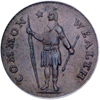 |
1788 Massachusetts Cent. Period after "Massachusetts". PCGS graded AU-58. Lightly circulated and toned a light to medium brown color. This one is sharp, with strong details on the Indian and CENT and the shield are all sharp. Trivial handling marks in the fields, but they are not distracting.
Estimated Value $1,500 - 2,000.
View details and enlarged photos
| Unsold |
Lot 60 |
|
Withdrawn
| Unsold |
Lot 61 |
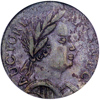 |
1785 Connecticut. African head. PCGS graded EF-40. One of the finest graded of this popular variety. The devices are well struck and the coin has nice brown toning on the obverse, while the reverse has thick red patina over brown. PCGS has graded 2 as such, with 2 higher as AU-50, and the finest they've seen is AU-53. A rare and desirable item, and one that is seldom found in grades even approaching this.
Estimated Value $1,500 - 2,000.
View details and enlarged photos
| Realized
$1,323 |
Lot 62 |
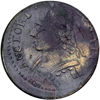 |
1787 Connecticut. ACG graded AU-50 our grade Sharpness of AU, but corroded. There is a small area of red corrosion on the lower left obverse, and other traces of corrosion can be seen with a glass. Struck slightly off center, but sharp on most of the devices. A coin to be inspected by prospective buyers.
Estimated Value $500 - 550.
View details and enlarged photos
| Unsold |
Lot 63 |
 |
1787 Connecticut. Mailed bust facing left. PCGS graded EF-45. Reddish brown in color and generally clean for the grade. These were all poorly struck on the upper device details, but the lettering and device outlines are all as clear as ever found.
Estimated Value $600 - 800.
View details and enlarged photos
| Unsold |
Lot 64 |
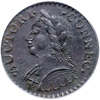 |
1787 Connecticut. Mailed bust facing left, laughing head variety. PCGS graded AU-55. One of the finest graded of this variety, this one with dark brown toning on both sides and generally problem free. We do note the surfaces are slightly rough on both sides, and there is some raised red patina on the upper reverse. Sharply impressed by the dies, and this variety is much scarcer than the Miller 6.1 laughing head variety. A similar example graded AU-50, but of the more common Miller 6.1 Laughing Head variety brought $3,450 in the March 2000 Bowers & Merena sale.
Estimated Value $3,000 - 3,500.
View details and enlarged photos
| Unsold |
Lot 65 |
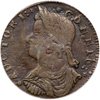 |
1787 Connecticut. Draped bust facing left. PCGS graded EF-40. Far better than normally encountered, the surfaces are medium brown and the devices are fairly sharp. No troubling spots or corrosion to be found. Few Connecticut cents look this nice! A perfect collector coin in grade and surfaces.
Estimated Value $650 - 850.
View details and enlarged photos
| Realized
$518 |
Lot 66 |
 |
1787 Connecticut. Draped bust facing left, "CONNFC" variety. PCGS graded EF-40. One of the few graded of this variety, we note dark brown fields and lighter devices. Sharp and well struck, with a small fissure through the obverse planchet, as struck. PCGS has graded 1 this high, with 1 a notch above, and the finest is AU-53 currently. Not many to go around of this rare die combination.
Estimated Value $700 - 900.
View details and enlarged photos
| Realized
$604 |
Lot 67 |
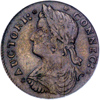 |
1787 Connecticut. Draped bust facing left, "ETLIR" variety. PCGS graded EF-45. One of the finest graded of this variety, and PCGS has only seen two graded XF45, with a single coin graded higher as AU-55 of the ETLIR variety. The planchet here is very choice, and the color is just about perfect too, being a light brown throughout, with no spots or similar problems to be found.
Estimated Value $750 - 1,000.
View details and enlarged photos
| Realized
$518 |
Lot 68 |
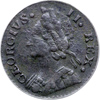 |
"1747" Machin's Mills Copper Halfpenny. SEGS graded VF-30 "*" holder, "Uniform Corrosion". Dark brown in color with corrosion over the obverse and reverse, but even enough in color and not as distracting as it might sound. Well struck by the dies, with the date and devices all bold. One of the first of the Machin's Mills coins, this one has King George II on the obverse (facing left), while later issues show King George III facing right.
This is one of the scarce Mould-Atlee "Tory Coppers" produced at Mould's Mint located at 32 Williams Street, New York City. They have been punch linked to Walter Mould and thus to the Constellatio Nova coppers. Mould was a pupil of Thomas Wyon, the famous British coiner, and Mould emigrated to America in 1785. After Mould arrived in America, he pieced together a living coining imitation British halfpence (the "Bungtown coppers" or more recently "Tory coppers"). Although there were no legal penalties for making these light weight coppers, Mould likely kept his enterprise a secret, as he was trying to land more lucrative and legitimate work of making coins for various states in the Confederation.
Estimated Value $1,000 - 1,500.
From the Paul Arthur Norris Collection.
View details and enlarged photos
| Realized
$776 |
Lot 69 |
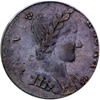 |
1787 Nova Eborac. Figure facing right. PCGS graded AU-50. This is Breen-989. Light brown in color and well preserved, although we note the planchet is not quite perfectly smooth, it is certainly far better than most copper encountered from the period. Struck slightly off center on the obverse towards one o'clock, with the obverse lettering weak in areas and some of the tops of the letters are off the edge. The male figure is reasonably sharp, and the curious domed hair is a copy from the earlier Connecticut coins. Clean surfaces and a very choice specimen for the grade. PCGS has graded only a single coin in this category, with 2 higher, one each in the next higher AU grades, according to that service. An important offering which would be difficult to best.
These were struck by John Bailey probably in the summer of 1787 at his mint in New York City and possibly in the Ogden and Rindell mint in Elizabeth Town, New Jersey, and they have been punch linked by Breen to the famous Brasher coinage. The motto, VIRT. ET LIB. is Latin for "strength and freedom".
Estimated Value $2,000 - 2,500.
View details and enlarged photos
| Unsold |
Lot 70 |
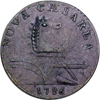 |
1786 New Jersey. Narrow shield. PCGS graded MS-62 Brown. A specialists delight here, first off the color is light brown and pleasing, with traces of reddish toning intermixed on both sides. The strike is sharp and even the shield lines are full. Remarkably free of handling marks, and this one seems undergraded if anything. We suggest careful study by specialists, as this is really a nice one so far as we can tell.
Estimated Value $5,000-UP.
View details and enlarged photos
| Realized
$6,900 |
Lot 71 |
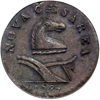 |
1787 New Jersey. Shield outlined. PCGS graded AU-53. Light tan in color with a pleasing appearance on the obverse, the reverse on a slightly rough planchet, with trivial flaws seen mostly near the edge. A sharply struck coin, with full details on the horse and plow, and the shield is also very bold. Identifiable by an ancient thin line from the shield through the lower left serif of the E of E PLURIBUS to the rim. Die cracks at the center of the shield, as the dies were starting to break down from use. A very nice type example of this important colonial issue which is seldom found this nice, and often much worse in grade.
Estimated Value $1,200 - 1,500.
View details and enlarged photos
| Realized
$1,208 |
Lot 72 |
 |
1788 New Jersey. Horse's head facing right, running fox variety. PCGS graded AU-50. A rare and desirable coin in this grade, the running fox variety is quite scarce and seen on only one reverse die, with a small fox left of the E of E PLURIBUS. The surfaces are a dark brown, and display minor roughness visible with a glass. Glossy and evenly toned. PCGS has only graded 11 of these, and this is the second finest seen and alone as the only AU-50, nudged out from the top spot by an AU-53. A premium rarity that will no doubt find many suitors.
Estimated Value $5,500 - 6,500.
View details and enlarged photos
| Unsold |
Lot 73 |
|
Withdrawn
| Unsold |
Lot 74 |
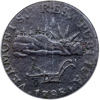 |
1785 Vermont. "Vermonts". PCGS graded VF-25. Dark brown and olive surfaces from minor roughness. Sharply impressed with all the trees, sun and mountains well defined, as well as the plow below. A scarce variety and is always in strong demand, especially in a decent collector grade like this.
Estimated Value $1,400 - 1,600.
View details and enlarged photos
| Unsold |
Lot 75 |
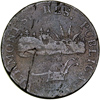 |
1785 Vermont. "Vermonts". VF-25 porous. This is the scarcest of the three major landscape design Vermonts. As often found on copper, the surfaces are uniformly porous and there are a few planchet fissures on each side. Evenly worn and well struck, the important design elements are all sharp and well defined. The reverse is particularly well struck, with the all seeing eye and glory rays and stars bold.
Estimated Value $1,100 - 1,300.
View details and enlarged photos
| Unsold |
Lot 76 |
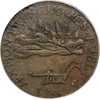 |
1786 Vermont Copper. "Vermontensium". PCGS graded AU-55 "Benson". Obverse with seven trees, ray points between ES. U of PUBLICA sharply recut low, diagnostic of this obverse. One of the very finest graded of this variety, PCGS in their Population Report note 4 graded this high, with just a single coin graded higher, that a thin hair above at AU-58. No mint state coins have yet been graded. Further, most of those seen grade from VG to VF, and these are frequently found on less than perfect planchets. On this particular example we note a few minor planchet flaws, one on the edge above NS of VERMONTENSIUM, another on the reverse edge above the M of DECIMA. Toned a natural chocolate brown in color, with darker areas noted around the trees. The strike on and around the plow is particularly nice, and the fields and surfaces are very nice for the grade. Localized striking weakness is noted on ENSIUM and on the opposing areas of the reverse. The central reverse all seeing eye is sharp, and the coin is well centered. An impressive example of this important variety that is certain to attract many appreciative numismatists who would find it a welcome addition to their collections.
The Latin obverse legend of VERMONTENSIUM RES PUBLICA translates to "the Republic of the Green Mountains" (Ryder/Slafter) and the obverse device was to consist of "A sun rising, with mountains and trees in the foreground, and a plough in the field beneath." while the reverse device had to have "A radiated eye, surrounded by thirteen stars" and the legend QUARTA. DECIMA. STELLA. or the fourteenth star, referring to Vermonts desire to become the next state after the original thirteen colonies joined to form the United States. This did come pass, but not until 1791 when Vermont officially became the 14th state to join the union.
After the necessary legislation and authorization, the bond requirements were met and suitable lodgings for the coinage we procured, Reuben Harmon began coinage in earnest. Reports vary, but it has been suggested that the coining equipment obtained could strike as many as 60 pieces per minute, although usually half that number were coined using the screw press (Ryder/Slafter). An historic example of this precious state coinage made during the brief tenure after the Revolution, but prior to the Vermont joining the other states officially in the Union.
Estimated Value $5,000 - 6,000.
From the Paul Arthur Norris Collection and purchased from our Benson I Collection Sale, 2/2001:80.
View details and enlarged photos
| Realized
$6,038 |
Lot 77 |
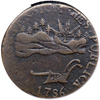 |
1786 Vermont. "Vermontensium". PCGS graded VF-20. Well struck on the obverse devices, and on a decent planchet, complete with a little extra metal on the upper rim. The reverse is unevenly struck, and weak on the left side. One minor planchet fissure on the upper left of the reverse, and a couple of minor streaks can be found on either side, but they are not that distracting. All things being equal the color is a pleasing tan which is rather nice for the issue. Always in demand and a popular issue.
Estimated Value $1,200 - 1,500.
View details and enlarged photos
| Unsold |
Lot 78 |
 |
1787 Vermont. Britannia. PCGS graded AU-50. Toned with deep chocolate brown surfaces and glossy throughout. The reverse is weak as always seen for this Machin's Mills issue, although Brittania is very plain and defined, the peripheral lettering is somewhat weak. RMON of VERMON is double struck, with the offset very clear with the N on Liberty's head from the first strike. With the diagnostic reverse weakness, we can't see any evidence of double striking there. The obverse die has a long die crack through the head and neck. On the reverse we note a minor spot on Brittania's thigh, and a thin scratch from her calf up to the rim on the left. A rarity in all grades, and we note that PCGS's online Population Report shows only 4 graded this high, with a single coin graded higher at AU-55 of this variety. An exciting coin which is further enhanced by the double striking on the obverse.
Estimated Value $2,000 - 2,500.
View details and enlarged photos
| Unsold |
Lot 79 |
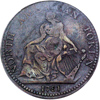 |
1781 North American token. PCGS graded EF-40. Dark brown in color and we note a few areas of light corrosion on both sides. Nice surfaces otherwise, and always a popular coin for the ship motif.
Estimated Value $500 - 600.
View details and enlarged photos
| Realized
$311 |
Lot 80 |
 |
(c.1785) Bar "Copper". PCGS graded AU-58. Nearly perfect surfaces on this one, a medium light brown color and no signs of abuse. There are a couple of very light specks on the reverse between the bars. Boldly struck and well centered, and truly an American classic in every sense of the word. The diagnostics of the A over the S are clear, as is the small spur on the right end of the second bar, which confirm this to be one of the originals. The first bar coppers were reported in the New Jersey Gazette, November 12, 1785 which is likely near time of their release.
Charles Bushnell attributes this issue to the famous George Wyon III and his Birmingham Mint. The coins were likely ordered by an American merchant, perhaps using a soldiers button for the simple, but endearing design. These coppers were struck at a lighter standard than the usual 60 to the pound, but they likely passed at 14 to the shilling, nowhere near the "cent" value long attributed to these because of their similarity in size to later large cents. Most of the survivors grade from Fine to Very Fine, and rarely are these encountered in grades even approaching mint state. PCGS has graded only 4 as AU-58, with 7 listed in their Population Report in various mint state grades, all of which are in the "brown" category.
Estimated Value $5,000 - 7,000.
From the Paul Arthur Norris Collection and purchased privately some years ago.
View details and enlarged photos
| Realized
$6,210 |
Lot 81 |
 |
(c.1792-94) Kentucky Cent. Lettered edge, "LANCASTER". PCGS graded MS-65 Red. Tied for the finest graded of this important Colonial issue, and in full blazing red! Obviously, this Kentucky cent was set aside by a collector at the time of issue, and protected from the normal elements that tone these coins. Breen believes these were struck for general circulation in America at Westwoods Birmingham Mint by the masterful engraver John Gregory Hancock. They were struck in copper, with a variety of edge designs, with this Lancaster edge one of the more common and the most likely to be found in high grades. PCGS has graded only 6 this high, with none higher save for a single MS-66 in Brown! An exciting coin to view and no doubt own.
Estimated Value $4,000 - 5,000.
View details and enlarged photos
| Unsold |
Lot 82 |
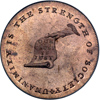 |
(c.1792-94) Kentucky Cent. Lettered edge, "LANCASTER". PCGS graded MS-64 Red. Splendid bright red in color, with boldly struck devices and perfectly centered. A few minor ticks from gem, and apparently from a small hoard of these discovered in England as PCGS has graded 33 this high, with just 6 graded higher, all MS-65 Red above. A beauty that most collectors would long cherish.
Estimated Value $1,800 - 2,200.
View details and enlarged photos
| Realized
$1,553 |
Lot 83 |
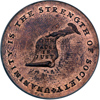 |
(c.1792-94) Kentucky Cent. Lettered edge, "LANCASTER". PCGS graded MS-64 Red. Satiny and well struck, this one has glowing red color which is slightly mellowed today. Clean surfaces and well preserved, but we note a minor planchet flaw at the center of the reverse. PCGS has graded 33 this high, with 6 higher in the red category.
Estimated Value $1,800 - 2,200.
View details and enlarged photos
| Unsold |
Lot 84 |
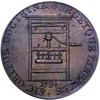 |
1794 Franklin Press token. PCGS graded MS-64 Brown. Sharply struck and one of the finest seen by PCGS, the surfaces are toned a medium brown color and there is no sign of weakness to be found. Always in demand for the reference to Benjamin Franklin, who worked at Watt's Printing Works on Wyld Street in London for part of 1726. This is an early die state before the crack appears within the press. PCGS has graded 9 this high, with a single coin higher in all color categories.
Estimated Value $1,400 - 1,600.
View details and enlarged photos
| Unsold |
Lot 85 |
 |
1794 Franklin Press token. VF-25. Mottled brown colors and glossy. These are always popular for the Franklin reference.
Estimated Value $200 - 250.
View details and enlarged photos
| Realized
$242 |
Lot 86 |
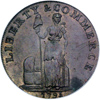 |
1795 Talbot, Allum & Lee Token Cent. PCGS graded MS-64 Brown. Lovely medium brown in color with luster in the fields. Boldly struck, including all elements of the ship. One old spot on the lower right obverse, but this does not detract a lot. Excellent surfaces throughout, and perfect for the colonial specialist.
Estimated Value $800 - 900.
View details and enlarged photos
| Unsold |
Lot 87 |
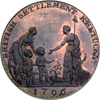 |
1796 Myddleton Token - Copper. PCGS graded Proof 64 Red and Brown. This is the finest graded by PCGS in Red and Brown (there are no Red examples graded) according to their online report (July 11, 2002). The only other example is a higher technical grade of PR-65, but that example is "Brown" instead of Red and Brown as seen here. With copper, it is more desirable to have as much original red as possible and this example has substantial red remaining. We do note some minor spotting, expected on a coin of this age, the most evident on the B of BY on the reverse. The devices are well frosted, and the fields fully mirrored, which combined produces contrast that any true collector will fall in love with. It is likely that less than 10 are known, although a review of several sales failed to match this specimen to a previous auction appearance, this is not the Garrett, Norweb, Picker, Robison, Walter, Pittman or Roper specimen. Regardless, this is magnificent coin that boasts a full strike, glorious surfaces and color, and extreme rarity. Further, it is an historically relevant issue, proposed as a circulating coin for Myddelton's colony in Kentucky. The tokens were struck by Matthew Boulton with dies almost certainly engraved by Conrad Küchler.
Extensive research on the Myddelton tokens was done by Richard Margolis and his findings were published in The Colonial Newsletter in December 1999, a copy of which is available for the purchaser of this copper or the silver Myddelton token in this auction. The copper specimens were the intended issue, but for some reason a number of silver pieces (thought to have been 53) were struck first by Boulton on March 8, 1796. Of the copper specimens, Boulton's Medal Ledger shows only 11 were produced from the entire ledger period 1793-1816 (Margolis). Myddelton was preparing to leave for Kentucky in early March of that year, and had intended to take with him at least a ton (several thousand) of these copper tokens. However, the hand of fate intervened days before he was to board ship and Myddelton ended up in Newgate Prison as soon as these tokens were ordered from Boulton, charged and convicted with trying to hire a talented workmen from England for employment outside England, violating a 1783 statute prohibiting such acts. Boulton apparently ended up with most of the silver examples he struck, and made a very small number of copper tokens which he kept secret lest he be dragged into Myddelton's legal problems.
In a letter from Philip Parry Price Myddelton to Matthew Boulton (Margolis article) dated January 24, 1796, Myddelton revises his request for the dies and coinage for his proposed settlement in Kentucky starting with the reverse as follows "…Britannia with her head pendant, her spear reversed and leaning on her shield, before her the demons of Discord and tyranny treading under foot the Emblems of Liberty and justice. Legend "Payable by P.P.P. Myddelton". On the obverse "the figure of Liberty holding out her hand to welcome two little genii presented to her by Hope, at the feet of the figure of Liberty the Emblems of peace and Plenty. Legend "British Settlement Kentucky 1796"." Most of these elements were employed by Kücher and his engraving represents one of the pinnacle moments of 18th century die engraving. Tragically, Myddelton's dream of floating a colony in Kentucky was capsized when he was arrested for the crimes mentioned, and spent the next three and a half years mouldering in Newgate Prison. Only a handful of the copper tokens remain to memorialize Myddelton's dream of a freer and more just world an ocean away from his prison confines. One of the most beautiful of all colonial issues and of extreme rarity and importance to all numismatists.
Estimated Value $15,000 - 20,000.
Here is a partial list of auction appearances of copper examples presented in no particular order of condition, as all are "Proof", with thanks to Richard Margolis as noted above, with some duplication likely as specimens reappear at auction. 1). This coin. The Paul Arthur Norris collection and purchased from our Fairchild Family Trust Collection, May 28, 2001, lot 63 at $18,975. 2). ANS ex Norweb. 3). Numismatic Gallery 5-10-53 sale, Bowers and Merena's Norweb Sale, 10-13-87:1401. 4). Stack's Roper Sale 12-9-83:350. 5). Stack's Auction '83 session, 7-29-83:515 to John Whitney Walter, Stack's Walter Sale 5-4-99:1704. 6). Ellsworth/Garrett, Bowers and Ruddy's Garrett Sale, 10-2-80:284. 7). Stack's Richard Picker Sale, 10-24-84:284. 8). David Aker's Pittman Sale 10-21-97:121 at $13,750.
View details and enlarged photos
| Realized
$16,675 |
Lot 88 |
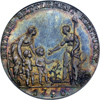 |
1796 Myddleton Token - Silver. PCGS graded Proof 63 Premium Quality. A mate to the copper specimen in this sale, this silver example boasts gorgeous antique toning with colorful hints around the periphery, and more lavender gray elsewhere. As to the strike, it is full and complete, with no hint of weakness on the central devices, even Liberty herself is bold. This fact is particularly relevant because our consigner, Paul Arthur Norris, owned the technically higher grade coin (PCGS PR-64) which was weakly struck on Liberty's body and head, but sold it after he acquired this piece. This other silver example was sold in our Mouhtouris sale, October 1, 2001, lot 56 where it realized $17,825. Comparing the two, Mr. Norris felt that the sharper strike was more important than the technical grade, given that both were choice proof coins. Larry Goldberg agreed with Norris that this specimen should be considered a finer and more valuable example because of the full strike on Liberty and both agreed that this coin was finer overall of the two. On this particular coin, there are some minor hairlines which likely limited the grade, but this coin is certainly very appealing for its color, strike and surfaces. As to the PCGS Population Report, they note 7 graded as PR-63, with just one higher, the example Norris sold as PR-64, out of a total of 11 examples graded in all. Needless to say, any Myddelton token is extremely rare and seldom offered. Despite the number issued (see below), auction records indicate perhaps 15 to 20 are known in all grades.
The Myddelton tokens represent one of the pinnacles of die engraving of the period. The complex design elements are rich in minute details and speak volumes to those symbolically literate. The obverse shows a youthful Liberty, her right arm outstretched while her left arm holds a pole which supports a loose cap (the Phrygian cap on the pole has been traced back to Roman times when slaves, who wore such caps, placed their caps on poles to assert their freedom). Behind Liberty is a cornucopia, which is spilling forth fruit symbolizing the abundance of the new colony in Kentucky, and a small Liberty tree or branch, ringed with a wreath of Laurel near her feet (for peace). The image of Hope is on the left, presenting two children (genii, or supernatural spirits which take human form to serve their summoner) that represent the freedom and opportunity of the new colony. The ships anchor perhaps speaks of the long voyage to the new land, and once arriving being anchored to the land, as the anchor rests on the land as opposed hanging from a ship or on deck.
Britannia dominates the reverse, her head lowered and weeping, her spear reversed (point down) and leaning on her shield (note the flag elements there), the symbols of Liberty (scales of justice, the fasces and Liberty cap) lie in disarray at her feet, suggesting that Britain had become a land devoid of justice and liberty in recent times. All these elements combine to entice people to move to the new settlement. Interestingly the Soho Mint owner, Matthew Boulton wrote P. P. P. Myddelton on January 7, 1796 to inquire about Myddelton's request that Britannia be presented in such a manner on his proposed token as follows "In regard to the device I do not think myself qualified to speak of it, as I do not clearly see what point you aim at, or what passes in your mind, or why you should prefer Britannia weeping over your plantation, as I hope both you & Britain will have cause to rejoice." (see article by Richard Margolis noted below) Myddelton didn't see it that way, and stuck to his original concept of a weeping Britannia. The extensive research done by Richard Margolis and published in The Colonial Newsletter in the December 1999 issue is available in our office, and we strongly suggest anyone who has an interest in the Myddelton tokens to take the time to read this superbly researched article to gain a thorough understanding of these important coins.
The Margolis research notes that Myddelton originally contracted with Boulton's Soho Mint for copper coins, and in the surviving correspondence there is no reference to the silver pieces. Perhaps these silver pieces were struck for advertising purposes most likely for use by the Soho Mint and Boulton, as Myddelton was scheduled to sail to Kentucky within days of these silver coins being struck, and would have had little time to present the silver coins to prospective colonists. Of the 53 silver pieces struck, 50 were put into Myddelton's account, and shortly thereafter 46 were returned to Boulton's Soho Mint, where they were quietly distributed over the next few years, Boulton fearing reprisals from the government and wanting to distance himself from the problems that soon entangled Myddelton.
Meanwhile, Myddelton's past caught up with him, and he was arrested for attempting to entice an Englishman to move to his new Kentucky colony, which was illegal at the time. Myddelton ended up in the horrible Newgate Prison, where his one year sentence lasted over 3 years, when he at last was able to pay the £500 fine and released. We don't know if Myddelton ever made it to Kentucky, but he resurfaced in Britain as the plaintiff in another lawsuit in 1806.
Estimated Value $12,500 - 17,500.
From the Paul Arthur Norris Collection and purchased from our Fairchild Family Trust sale, May 28, 2001, lot 56 at $14,950.
View details and enlarged photos
| Realized
$17,250 |
Lot 89 |
 |
1796 Castorland Silver Medal. Unbroken die. PCGS graded MS-64. A rare original example of this medal, that approaches gem! The surfaces display a delicate pinkish hue over silvery gray tones atop the mirror fields. Boldly struck on both sides, without any signs of weakness on the high points of the devices. These were struck at the Paris Mint, and were made to circulate in the new French colony being formed in upper New York, along the Beaver River. As the political climate changed dramatically with the French Revolution in 1792, those who had been in power or sympathetic to the Royals feared for their safety. The Reign of Terror began, and many aristocrats were hung or jailed. Those that could moved away, and some signed on to move to the new French American colony.
The legend FRANCO AMERICANA COLONIA translates to "French American Colony", with the central head device that depicts a women with a veil, and an unusual crown which appears like the crenelated tower from a castle. The French word "Castor", translates to "beaver", hence the colony became known as Castorland. Hence, the beaver motif on the bottom of the reverse, with the maple tree above, next to which stands the Goddess Ceres, patroness of agriculture, with a drill in one hand (to free the maple sap from the tree), and the open tap in the tree below, with the sap flowing freely, and a cornucopia in the other hand symbolizing the hoped for success in agriculture from the new colony. The Latin motto SALVE MAGNA PARENS FRUGUM, means "Hail, great mother of crops" (Breen), and is from Virgil's Georgics.
Epidemics and severe winters plagued those hearty souls in the first years of the new colony, and in short order most of the original inhabitants of Beavertown had either died or moved away, and within a few more years nothing remained of the colony except the original name. Most of the coins that arrived with the colonists were well circulated during these times, and few are found in mint condition, as we see here.
The Paris Mint retained the original dies, and continued to make more of these to order, but the reverse die cracked fairly early in the process, and subsequent strikes show a die crack. Further, the restrikes were of lighter weight, and can be easily distinguished from these originals. PCGS has graded a total of 15 of these in all grades of the originals, this one is tied for the finest with 2 others. Certainly an important coin for the colonial specialist, as many of these did circulate in America near their time of issue having been brought over with a few asylum seekers from post revolutionary France.
Estimated Value $7,000 - 9,000.
From the Paul Arthur Norris Collection and purchased privately.
View details and enlarged photo
| Realized
$7,763 |
Lot 90 |
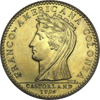 |
(1796) Castorland Medal. Silver restrike. SEGS graded Proof 64"Cornucopia/3 OR" Edge, 314.3 Grains. A rare and seldom offered example of this restrike medal in gold. We are not sure when this was coined, but T. Harrison Garrett purchased a similar restrike in gold in 1883. The SEGS holder notes this has the "Cornucopia/3 OR" on the edge, implying it was struck after 1880 but before 1900 when the edge symbols were dropped (see Breen's Encyclopedia). Proof restrikes made after 1900 have a matte finish, as compared with the brilliant finish seen here. Breen #1069, and he notes the gold examples are "rare". Boldly struck throughout, without any signs of weakness whatsoever in the design elements. The surfaces of this particular example are very clean, with no real signs of contact aside from faint hairlines. Bright and lustrous, and we note a couple of minor specks which may help identify this coin and link it to past sales, one is located at the left foot of F in FRANCO, and another is above the L in COLONIA. A majestic example of this sought-after medal that will certainly please the specialist.
Estimated Value $500 - 700.
From the Paul Arthur Norris Collection. A similar example in the Garrett Collection realized $1,100 back in October of 1980.
View details and enlarged photos
| Realized
$805 |
Lot 91 |
 |
1783 Washington token. "UNITY STATES". AU-58. Glossy brown in color and generally pleasing. The rims have a few ticks, but they are not distracting. Minor lines on the surfaces, as the planchets were made to look as though these coins had circulated from the time they were coined, and were obvious copies of the later large cent reverses of the draped bust type. Few are known in mint state, and this example is very close if not at that grade level. Obverse portrait of Washington with a laurel wreath of victory in this head, and the fanciful date of 1783 below, although these were likely struck in the 1820s.
Estimated Value $1,100 - 1,200.
View details and enlarged photos
| Unsold |
Lot 92 |
|
(c.1783) Washington Double Head Cent. VF-35. Well struck and pleasing for the grade.
Estimated Value $150 - 200.
View details
| Realized
$219 |
Lot 93 |
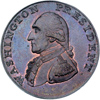 |
1791 Washington Cent. Small eagle. PCGS graded MS-65 Brown. An outstanding example for the advanced collector who needs a gem. There are traces of mint red but the surfaces and color are mostly a light brown. Fully struck on Washington's wig, and the epaulets are sharp as well. On the reverse, the eagle and shield are sharp as well, and there are not distracting spots or similar problems. PCGS has graded only 6 in this grade, with 2 more as RB, and 4 are graded higher, all MS-66 Brown at the very top. An impressive example of this very popular Washington issue.
Estimated Value $5,000 - 6,000.
View details and enlarged photos
| Realized
$3,220 |
Lot 94 |
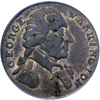 |
Washington "Success" medal. Small, with reeded edge. PCGS graded AU-53. Struck in brass, then silvered, this example retains some traces of the original silvering in the protected areas around the devices. Rare in all grades, especially so in high grades like this! Fully struck on the obverse and reverse, although the central all seeing eye is weakly defined. PCGS has graded only 2 as such, with 6 higher all as AU-58, and a single coin at the top as MS-61.
These medals have not been punch linked to any known mint and are of an unusual size. They were likely struck in England or the United States and have long been rumored to have been produced for Washington's second inaugural address in 1793, although no proof has yet been located. An impressive example of this popular and rare Washington item.
Estimated Value $1,700 - 2,000.
View details and enlarged photos
| Unsold |
Lot 95 |
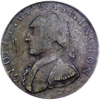 |
1795 Washington "North Wales" Halfpenny. Plain edge. PCGS graded EF-45. Dark brown in color and well preserved for this issue, the strike is uneven as always, with weakness on parts of the harp and in Washington's hair. PCGS has graded only 3 this high, and importantly, none are graded higher! Bear that in mind when formulating your bid.
Estimated Value $750 - 1,000.
View details and enlarged photos
| Realized
$1,093 |
Lot 96 |
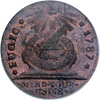 |
1787 Fugio Cent. Pointed rays, cinquefoils, "STATES UNITED". PCGS graded MS-65 Red & Brown. Tied for the very finest graded in the red and brown category by PCGS with just 4 coins, and an truly delightful coin to study. The surfaces are pristine, and show the usual light die cracks including the lower reverse rim crack towards the center, and some curious meandering cracks around the sun on the obverse. Further, the dies show just light clash marks, which helps keep the devices crisp and defined. Although a hoard coin, in this gem grade this is a true rarity and worthy of the finest colonial collection.
Estimated Value $6,000-UP.
View details and enlarged photos
| Unsold |
Lot 97 |
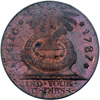 |
1787 Fugio Cent. Pointed rays, cinquefoils, "STATES UNITED". PCGS graded MS-64 Red & Brown. A choice coin for the numismatist, and this is about as nice as this issue can be secured. Struck from clashed dies, as are most, and the surfaces retain substantial original red luster, with some mellowing. One minor speck near the sundial, and we note some very minor streaks in the planchet. PCGS has graded 17 this high, with only 4 graded higher in the red category, making this one of the finest. A sharply struck, well preserved coin.
Estimated Value $3,000-UP.
View details and enlarged photos
| Unsold |
Lot 98 |
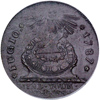 |
1787 Fugio Cent. Pointed rays, cinquefoils, "STATES UNITED". PCGS graded MS-64 Brown. Struck from clashed dies as are most, and a common hoard coin in most grades. However, they start to get difficult in grades like this, with PCGS reporting only 32 graded as such, with just 3 graded higher in brown, and another 17 as MS-64 in red and brown, and 4 at the top as MS-65 red and brown. An impressive coin, and one of a nice selection we have for the advanced colonial specialist.
Estimated Value $2,500 - 3,000.
View details and enlarged photos
| Unsold |
Lot 99 |
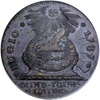 |
1787 Fugio Cent. Pointed rays, cinquefoils, "STATES UNITED". PCGS graded MS-63 Brown. Lovely brown luster and well struck from heavily clashed dies. One dark area on the lower left obverse, but this is minor. The sun shows a full face, and the details around the sundial are sharp and clear. A hoard coin, but still scarce this nice.
Estimated Value $2,200 - 2,700.
View details and enlarged photos
| Unsold |
|
|